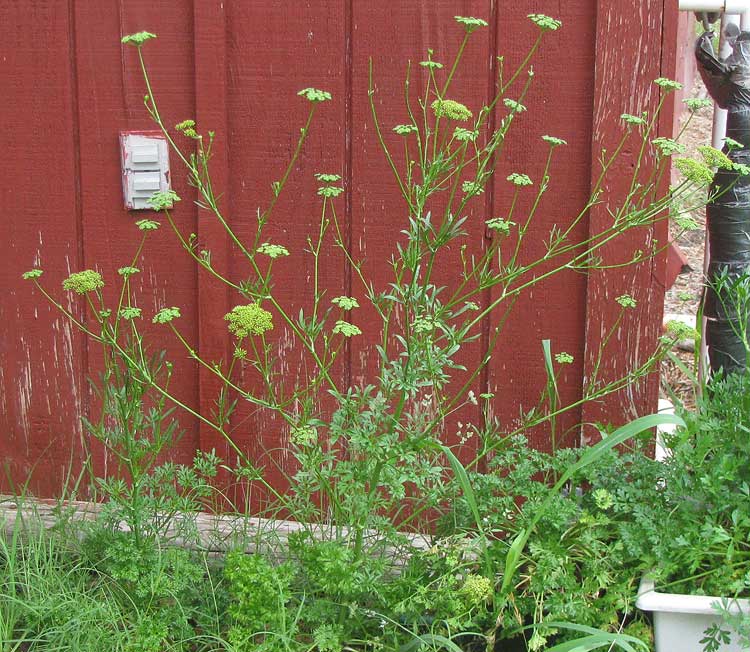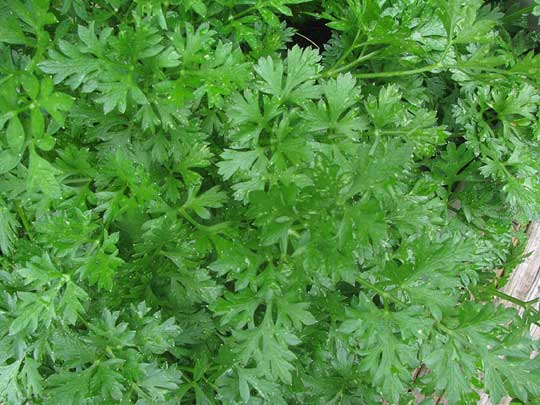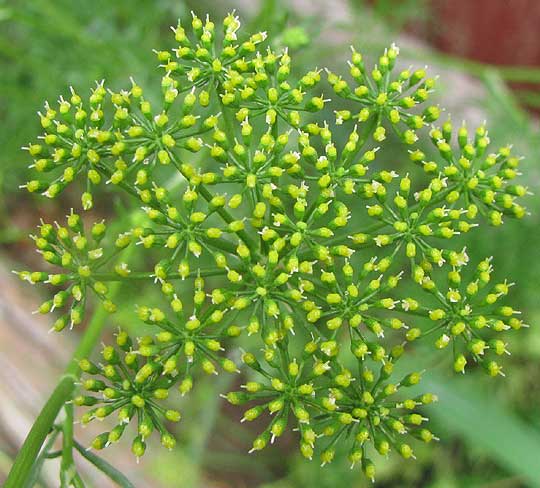Excerpts from Jim Conrad's
Naturalist Newsletter

from the June 16, 2013 Newsletter issued from the valley of the Dry Frio River in northern Uvalde County, southwestern Texas, on the southern border of the Edwards Plateau; elevation ~1750m (~5750 ft); N29.62°, W99.86°; USA
PARSLEY FLOWERING
All winter several basketball-size bunches of Parsley plants flourished beside the cabin. Their ferny leaves graced many delicious soups and salads. Now some of those plants have
"bolted" producing impressive flower-heads. You can see one above.
Parsley, PETROSELINUM CRISPUM, is a member of the large and important Parsley Family, the Apiaceae, with more than 3,700 species distributed across 434 genera. As the families of flowering plants are interpreted now, the Apiaceae is the 16th-largest, being home to such well known plants as Anise, Caraway, Carrot, Celery, Coriander or Cilantro, Cumin, Dill, Fennel, Hemlock, Queen Anne's Lace, and Parsnip. You can see Parsley's distinctive, ferny leaves below:

A good field mark for the Parsley Family is that its species produce flowers clustered in umbel-type heads. An umbel is a flat-topped or rounded -- umbrella shaped -- flower cluster in which individual flower stalks arise from about the same point. One of our Parsley's umbels is shown below:

That picture shows one big umbel composed of several smaller umbels, or "umbelets" -- like an exploding fireworks rocket that issues smaller bombs that themselves explode.
Early in the morning, at the edge of younger umbelets, tiny flowers are seen with five male stamens alternating with petals, as shown below:

By mid-morning the stamens and petals fall off, leaving the female part, the pistil, which will become the future fruit, as seen below:

In that picture the white, finger-like items pointed upward are styles. The Yellowish, shiny bases beneath the styles are stylopodia, which are glandular disks whose secretions attract pollinators. Stylopodia occur only in the Parsley Family.
All sources I've seen describe Parsley plants as biennials, meaning that during the first growing season the plant forms a low rosette of leaves, the leaves overwinter, than on the second year flowers appear, and once mature fruits are produced, the plants die. However, I received these plants from Phred across the river, and he swears that this is at least these plants' third year. Moreover, some of the roots of this plant appear to have sprouts prepared to form rosettes this winter. I just don't know what to say about this.
I will say, however, that Parsley is a wonderful plant, not only because of its tasty herbage, but because it's so nutritious, containing unusual amounts of vitamins and minerals. It's even considered medicinal by many, maybe its most powerful service being as a diuretic. There's a belief that if something makes you pee a lot, it's cleaning out your body, plus the peeing helps with urinary infections. Pregnant women shouldn't use Parsley medicinally, however, because too much can cause problems. It's even stated that Parsley can be used to get rid of head lice. Make a Parsley tea by infusing it in hot water, let it cool, soak a towel with it, and after shampooing wrap the wet town around the head for 30 minutes and allow to dry naturally.